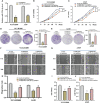A novel cuproptosis-related prognostic lncRNA signature and lncRNA MIR31HG/miR-193a-3p/TNFRSF21 regulatory axis in lung adenocarcinoma
- PMID: 35936736
- PMCID: PMC9353736
- DOI: 10.3389/fonc.2022.927706
A novel cuproptosis-related prognostic lncRNA signature and lncRNA MIR31HG/miR-193a-3p/TNFRSF21 regulatory axis in lung adenocarcinoma
Abstract
Lung adenocarcinoma (LUAD) remains the most common subtype of lung malignancy. Cuproptosis is a newly identified cell death which could regulate tumor cell proliferation and progression. Long non-coding RNAs (lncRNAs) are key molecules and potential biomarkers for diagnosing and treating various diseases. However, the effects of cuproptosis-related lncRNAs on LUAD are still unclear. In our study, 7 cuproptosis-related lncRNAs were selected to establish a prognostic model using univariate Cox regression analysis, LASSO algorithm, and multivariate analysis. Furthermore, we evaluated AC008764.2, AL022323.1, ELN-AS1, and LINC00578, which were identified as protective lncRNAs, while AL031667.3, AL606489.1, and MIR31HG were identified as risk lncRNAs. The risk score calculated by the prognostic model proved to be an effective independent factor compared with other clinical features by Cox regression analyses [univariate analysis: hazard ratio (HR) = 1.065, 95% confidence interval (CI) = 1.043-1.087, P < 0.001; multivariate analysis: HR = 1.067, 95% CI = 1.044-1.091, P < 0.001]. In addition, both analyses (ROC and nomogram) were used to corroborate the accuracy and reliability of this signature. The correlation between cuproptosis-related lncRNAs and immune microenvironment was elucidated, where 7 immune cells and 8 immune-correlated pathways were found to be differentially expressed between two risk groups. Furthermore, our results also identified and verified the ceRNA of cuproptosis-related lncRNA MIR31HG/miR-193a-3p/TNFRSF21 regulatory axis using bioinformatics tools. MIR31HG was highly expressed in LUAD specimens and some LUAD cell lines. Inhibition of MIR31HG clearly reduced the proliferation, migration, and invasion of the LUAD cells. MIR31HG showed oncogenic features via sponging miR-193a-3p and tended to positively regulate TNFRSF21 expression. In a word, lncRNA MIR31HG acts as an oncogene in LUAD by targeting miR-193a-3p to modulate TNFRSF21, which may be beneficial to the gene therapy of LUAD.
Keywords: MIR31HG; TNFRSF21; cuproptosis; lung adenocarcinoma; miR-193a-3p.
Copyright © 2022 Mo, Hu, Yang, Li, Bashir, Nai, Ma, Jia and Xu.
Conflict of interest statement
The authors declare that the research was conducted in the absence of any commercial or financial relationships that could be construed as a potential conflict of interest.
Figures











Similar articles
-
Establishment of a prognostic signature for lung adenocarcinoma using cuproptosis-related lncRNAs.BMC Bioinformatics. 2023 Mar 6;24(1):81. doi: 10.1186/s12859-023-05192-5. BMC Bioinformatics. 2023. PMID: 36879187 Free PMC article.
-
A cuproptosis-related long non-coding RNA signature to predict the prognosis and immune microenvironment characterization for lung adenocarcinoma.Transl Lung Cancer Res. 2022 Oct;11(10):2079-2093. doi: 10.21037/tlcr-22-660. Transl Lung Cancer Res. 2022. PMID: 36386454 Free PMC article.
-
A novel defined risk signature of cuproptosis-related long non-coding RNA for predicting prognosis, immune infiltration, and immunotherapy response in lung adenocarcinoma.Front Pharmacol. 2023 Aug 21;14:1146840. doi: 10.3389/fphar.2023.1146840. eCollection 2023. Front Pharmacol. 2023. PMID: 37670938 Free PMC article.
-
A novel prognostic signature for lung adenocarcinoma based on cuproptosis-related lncRNAs: A Review.Medicine (Baltimore). 2022 Dec 9;101(49):e31924. doi: 10.1097/MD.0000000000031924. Medicine (Baltimore). 2022. PMID: 36626411 Free PMC article. Review.
-
Differential expression and clinical significance of long non-coding RNAs in the development and progression of lung adenocarcinoma.Front Oncol. 2024 Jun 6;14:1411672. doi: 10.3389/fonc.2024.1411672. eCollection 2024. Front Oncol. 2024. PMID: 38912059 Free PMC article. Review.
Cited by
-
An efficient five-lncRNA signature for lung adenocarcinoma prognosis, with AL606489.1 showing sexual dimorphism.Front Genet. 2022 Nov 30;13:1052092. doi: 10.3389/fgene.2022.1052092. eCollection 2022. Front Genet. 2022. PMID: 36531243 Free PMC article.
-
An anoikis-related lncRNA signature is a useful tool for predicting the prognosis of patients with lung adenocarcinoma.Heliyon. 2023 Nov 11;9(11):e22200. doi: 10.1016/j.heliyon.2023.e22200. eCollection 2023 Nov. Heliyon. 2023. PMID: 38053861 Free PMC article.
-
Identification of a novel intermittent hypoxia-related prognostic lncRNA signature and the ceRNA of lncRNA GSEC/miR-873-3p/EGLN3 regulatory axis in lung adenocarcinoma.PeerJ. 2023 Oct 10;11:e16242. doi: 10.7717/peerj.16242. eCollection 2023. PeerJ. 2023. PMID: 37842058 Free PMC article.
-
The crosstalk role of CDKN2A between tumor progression and cuproptosis resistance in colorectal cancer.Aging (Albany NY). 2024 Jun 17;16(12):10512-10538. doi: 10.18632/aging.205945. Epub 2024 Jun 17. Aging (Albany NY). 2024. PMID: 38888512 Free PMC article.
-
Cuproptosis: mechanisms and links with cancers.Mol Cancer. 2023 Mar 7;22(1):46. doi: 10.1186/s12943-023-01732-y. Mol Cancer. 2023. PMID: 36882769 Free PMC article. Review.
References
-
- Kuhn E, Morbini P, Cancellieri A, Damiani S, Cavazza A, Comin CE. Adenocarcinoma classification: Patterns and prognosis. Pathologica (2018) 110(1):5–11. - PubMed
LinkOut - more resources
Full Text Sources

